Goleta Gets on Board with a Renoviction Urgency Ordinance
Takes Effect Immediately, to Be Reviewed in Early 2024
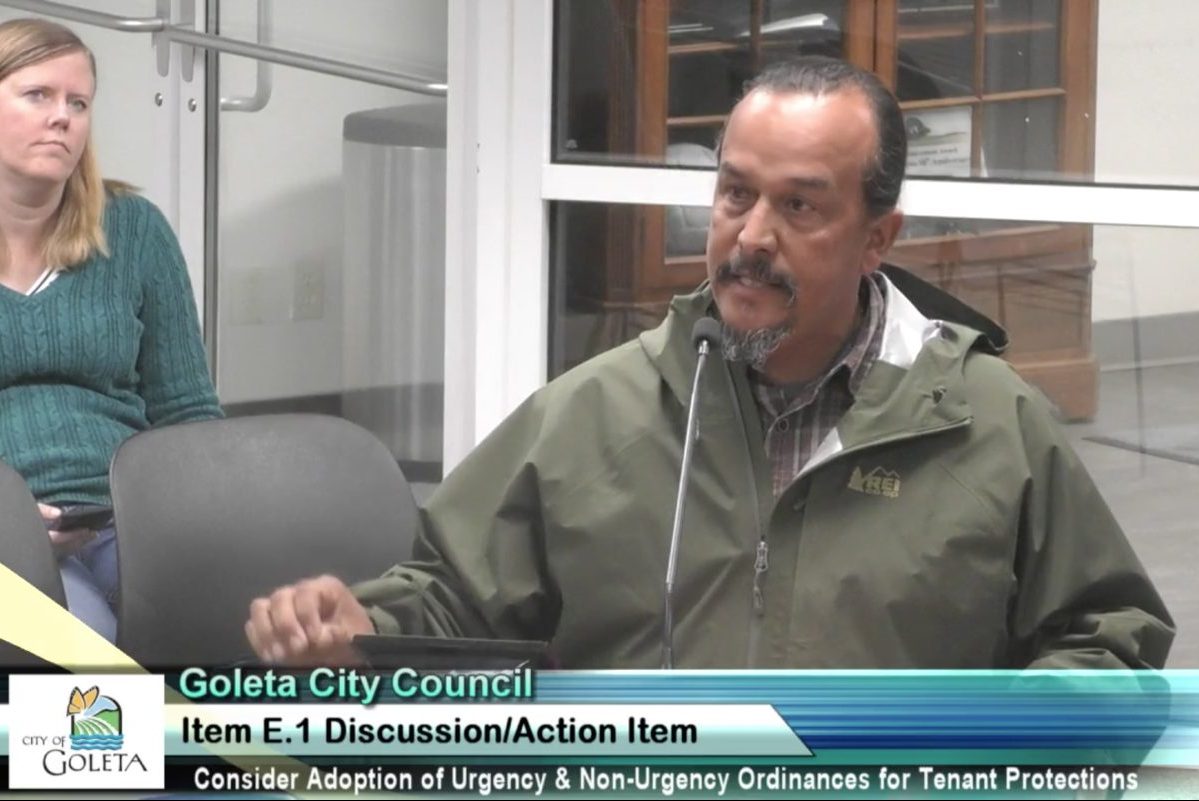
Renoviction got an airing at Goleta City Council on Tuesday night, as both renters and landlords argued the pros and cons of setting curbs on rental renovations and prices. After lengthy debate among the councilmembers, they voted unanimously to enact an urgency ordinance to set guidelines immediately regarding tenant evictions when landlords make major renovations; the council also agreed to reconsider the full ordinance in early 2024.
Mayor Paula Perotte put the problem succinctly, saying she’d seen renovictions occur in the City of Santa Barbara and in Isla Vista, and now in Goleta. “I also sit on our homelessness standing committee, and we are seeing people at risk of becoming homeless. It’s the rising costs of living, and these are people who have jobs, who have kids in schools here,” Perotte said. “I feel strongly that an ordinance is needed.”
While homelessness wasn’t what faced them, several real estate agents and owners of small properties expressed the view that the financial costs in the new ordinance could cause some of them to sell to a real estate investment trust or large corporation. Others argued the ordinance would deter owners from keeping their rentals in good repair. Rent control was part of the new law, they objected.
For a renovation that forces a tenant out of their unit for more than 30 days, the city’s rule gives the tenant the first right of refusal to return to their former home and limits a rent increase to 5 percent plus the consumer price index, or 10 percent if smaller.
Brian Johnson of the local Association of Realtors said a bathroom renovation, for instance, could cost $10,000. How does a 5 or 10 percent rent hike cover that?
Landlord Nick Gonzalez asked what happened when a tenant let a pipe leak all night and ruined a bathroom? He’d had this happen in an old unit, and he said his costs climbed to $100,000 after asbestos and lead were discovered and remediation was required. He asked the council to limit the ordinance to larger corporations and large properties. “This is all I have,” Gonzalez said. “No pension, no 401k, no guaranteed retirement.”
The new ordinance addresses older properties, not the high-priced homes of recent years — specifically, properties that received their certificate of occupancy more than 15 years ago.
Betty Jeppesen, president of the Santa Barbara Rental Property Association, asserted that elderly mom ‘n’ pop landlords couldn’t deal with the variety in local renoviction rules. “They can’t deal with enormous fines, prosecutions, being thrown in jail if they make a mistake. So they sell,” Jeppesen claimed. She implied mom ‘n’ pops didn’t necessarily know if they were in the city or the county.
The new ordinance is indeed complicated. Staff acknowledged they would work to set up a webpage and be available in English, Spanish, and Mandarin to explain the new rules to property owners.
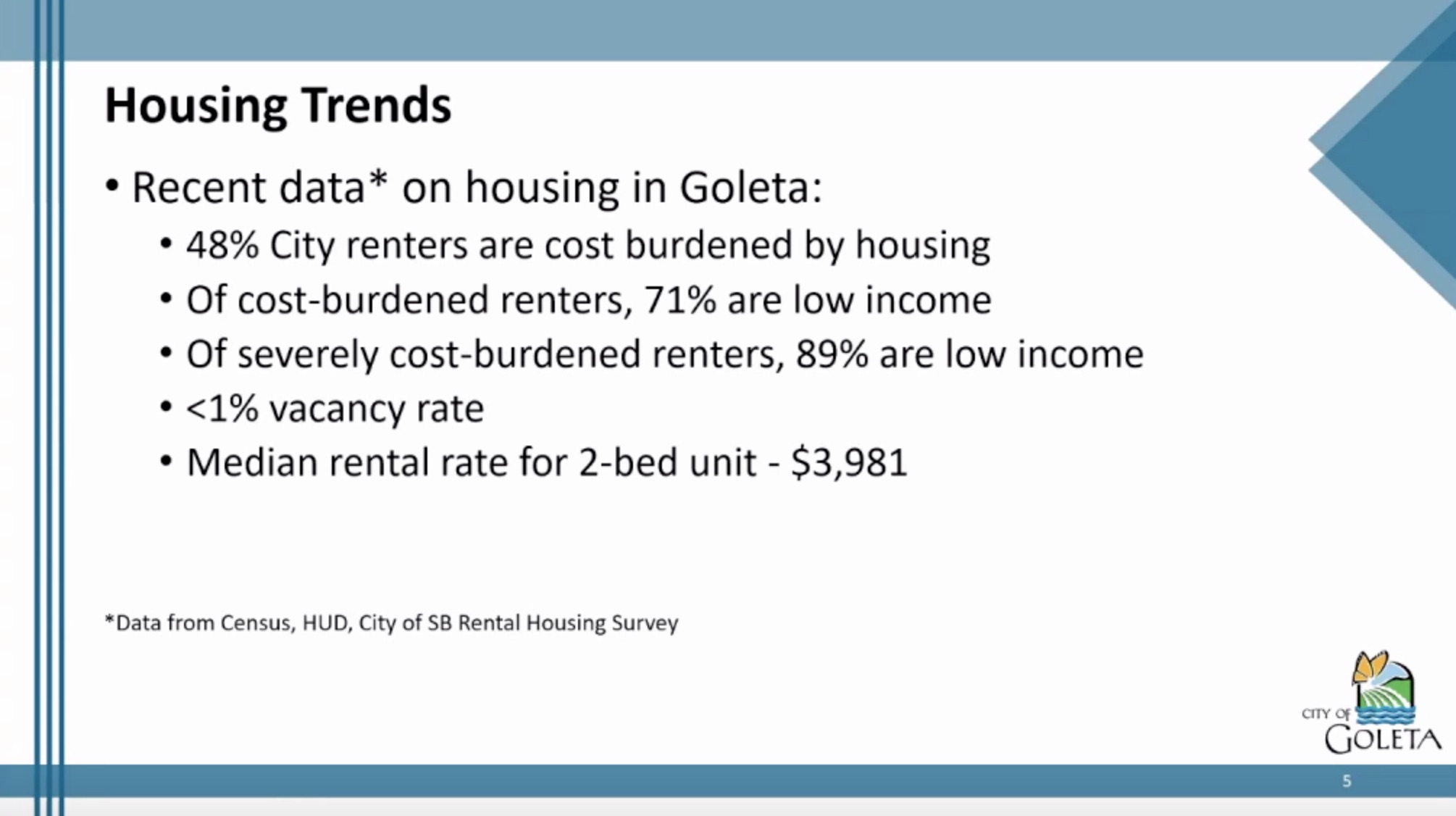
While landlords got some support from Councilmember Stuart Kasdin, who questioned staff at length about the mediation requirement if a lease were not renewed and whether the percent increase captured costs or not, the majority of the council was more concerned about long-term renters who were receiving eviction notices when a property changed hands, possibly on a pretext that a renovation was planned. This was the situation at a fourplex on Linfield Place that brought the first renoviction case to Goleta in October.
Describing himself as a longtime renter, Councilmember James Kyriaco addressed the landlords’ arguments, saying his constituents’ view was different regarding rent control: “I didn’t have to bring it up. They brought it up, asking when it was coming,” he said, adding that one-bedrooms were priced at $2,500 to $3,895. Kyriaco asked if property owners wouldn’t do well to fix their places now, before the flood of new housing from Housing Element requirements caused prices to possibly drop. And his Old Town district had many aging fourplexes. What would happen to those tenants if the ordinance were limited to five or more units?
Kyriaco was joined in this observation by Councilmember Kyle Richards, also an Old Town resident, who said that if four people lived in each unit, 16 people could be renovicted. “This can still affect a great number of people,” he said, while also expressing concern whether a 10 percent cap would create a disincentive to upgrade or do normal maintenance.
Under state law, a unit priced at $3,895 could see its rent go up by as much as $389 per month annually. This would be the maximum increase allowed in Goleta under the new renoviction ordinance.
In making the motion to pass the urgency ordinance, Kyriaco was reminded by Planning Director Peter Imhof that the city attorney recommended removing the right-to-return rent cap. “But what if I don’t want to do that?” Kyriaco said, smiling.
Councilmember Luz Reyes-Martín, the council’s new mayor pro tem, seconded the motion. An urgency ordinance requires four of the five to vote in favor, and Kasdin cast a “yes” vote, making it unanimous.
New Ordinance, Briefly
Lucy Graham, a senior housing analyst with Planning and Environmental Review, summarized the new urgency ordinance in a series of helpful slides, which can be viewed here (the urgency ordinance item begins at 2:13:10). The urgency ordinance encompasses more than renovictions, as described at the staff report here.

EXCEPTIONS: Properties exempted from the ordinance include owner-occupied dwellings or the same rented for less than a year, rentals connected with an employment agreement, vacation rentals, hotels, etc.
SB 567: This state law comes into effect in April 2024 and adds proof of permits for substantial remodeling and minimal occupancy requirements for owner move-in. Goleta’s new ordinance includes these provisions immediately and strengthens some of them.
LEASE: New and existing tenants must be offered a one-year lease if they don’t have one. This must occur within 90 days of the ordinance adoption and specify the rental rate for the year period.
JUST-CAUSE EVICTION: This can be for at-fault acts — such as nonpayment of rent or criminal activity — and no-fault acts, such as an owner’s desire to occupy the rental, substantially remodel it, remove it from the market permanently, or comply with code. These require a 60-day notice and relocation assistance to tenants. For the specific reason for the eviction, the owner must provide proof it has occurred; otherwise, a tenant has the right to move back in. Copies of such documents must go to Planning and Environmental Review under penalty of perjury.
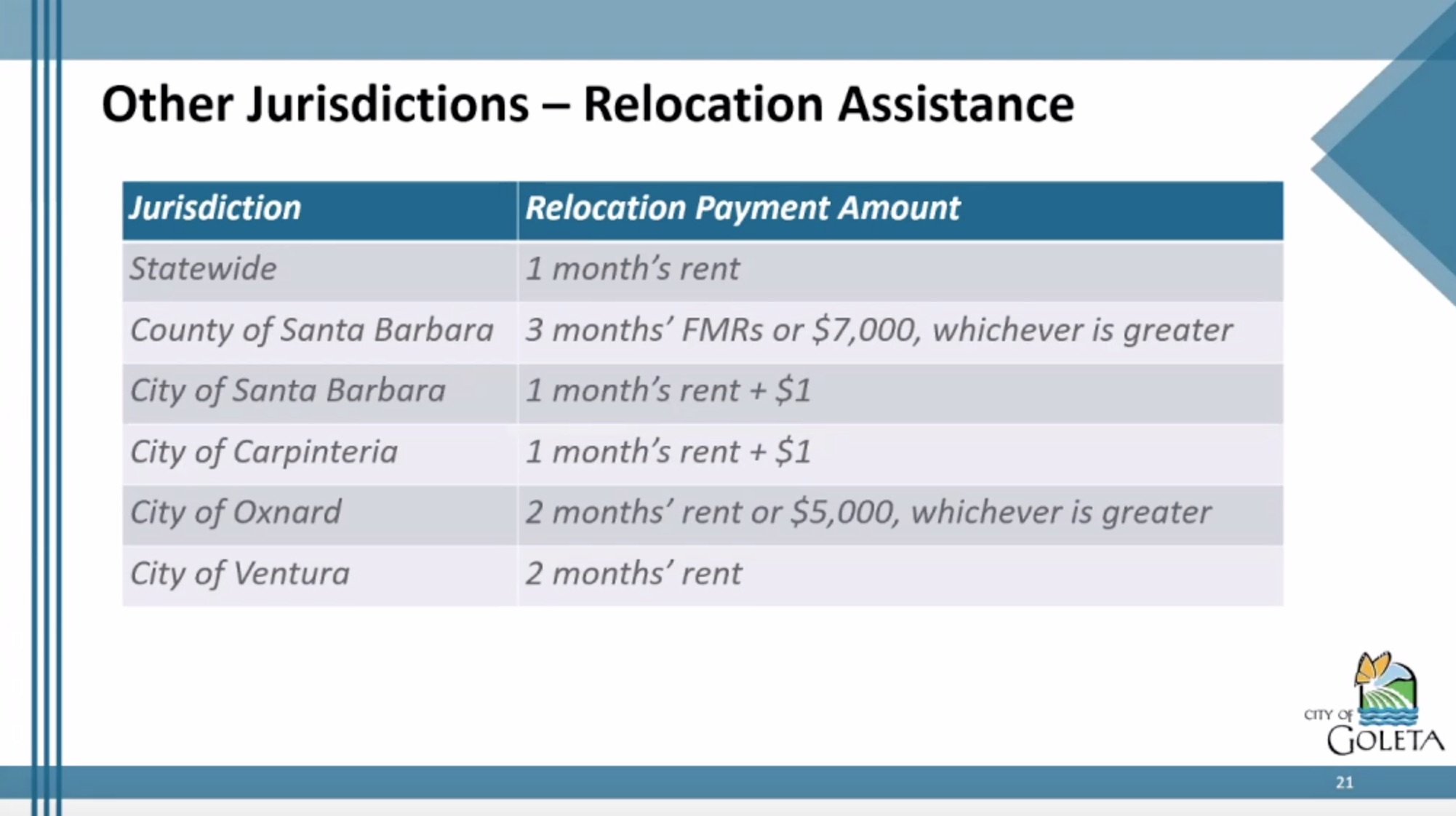
RELOCATION ASSISTANCE: In the case of no-fault just-cause eviction, landlords must help their tenants move. Graham provided a table showing how different jurisdictions have handled the obligation. Goleta chose to adopt two months of rent as the relocation assistance amount.
SUBSTANTIAL REMODEL: Clearly, the laws and ordinances are written with “good faith” participation by landlords debatable. State law left a no-fault loophole that allowed tenants to be removed for renovation; some landlords used renovation as a pretext to evict tenants and bring in new ones at much higher rent; this typically happened to long-term renters with lower rents.
Before a tenant can be evicted for a remodel — what has come to be known as “renoviction” — the landlord must acquire the needed permits for the work; copies must accompany the notice to terminate tenancy and include the reason for the eviction, type and scope of work to be done, why the work cannot be done with the tenant in place, and explain why the tenant must leave for more than 30 days. Copies are to go to city planning.
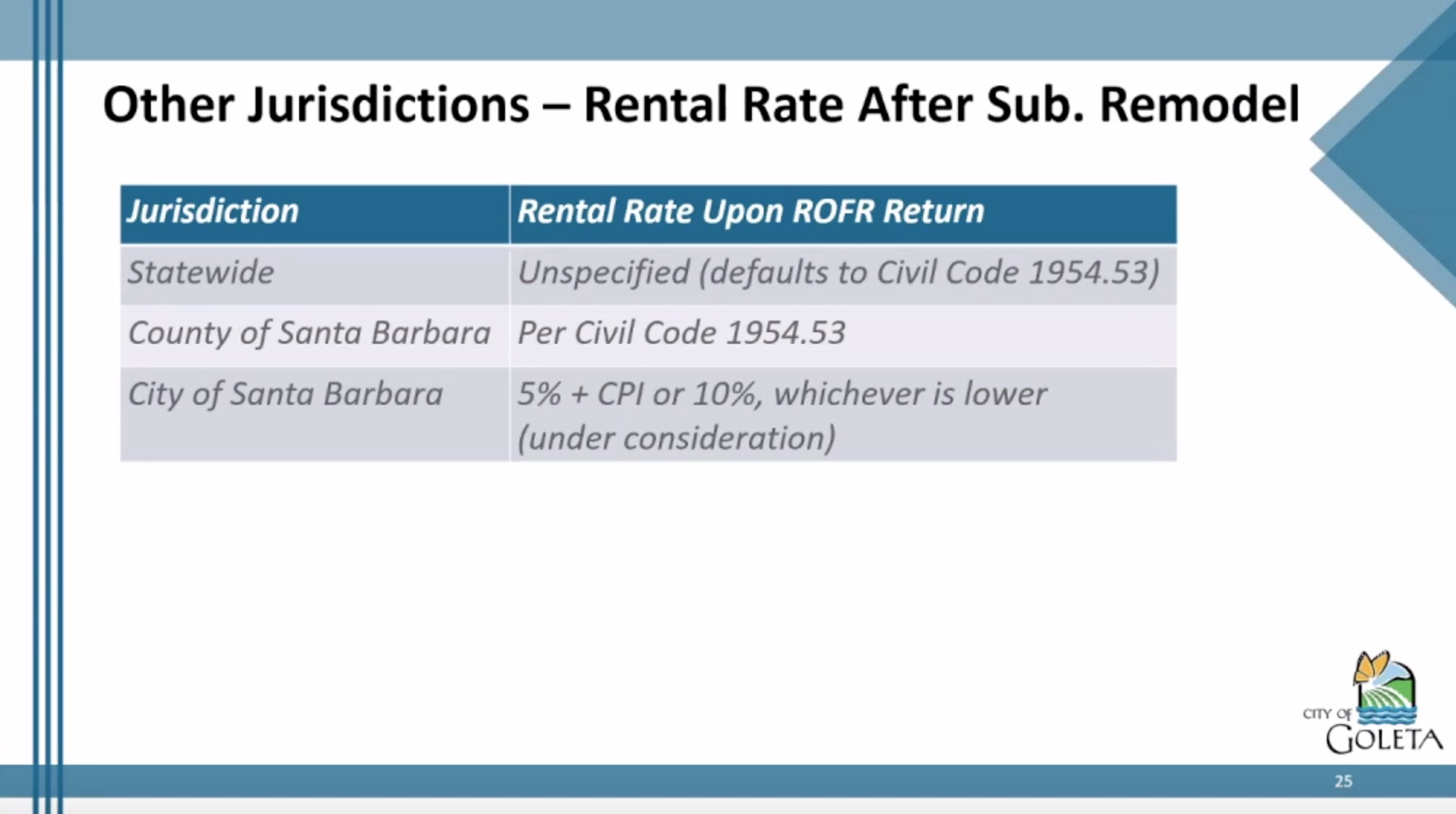
MANDATORY RIGHT OF FIRST REFUSAL: In the case of a notice of termination for renovation, the notice must inform the tenant they have the right to return once the renovations are completed. The tenant must provide their new address, phone, and email. When the remodel is done, the offer to re-rent must be in writing, include the lease term and price, and the price may increase by no more than 5 percent of the previous rent plus consumer price index, or 10 percent, whichever is smaller. The tenant has 30 days to accept in writing.
ADDITIONAL PROVISIONS: Landlords may not retaliate against tenants. Noncompliance with the ordinance renders a notice void and provides a legal defense for tenants. Willful oppression or malice can triple damages. Tenants may file for themselves and other tenants.
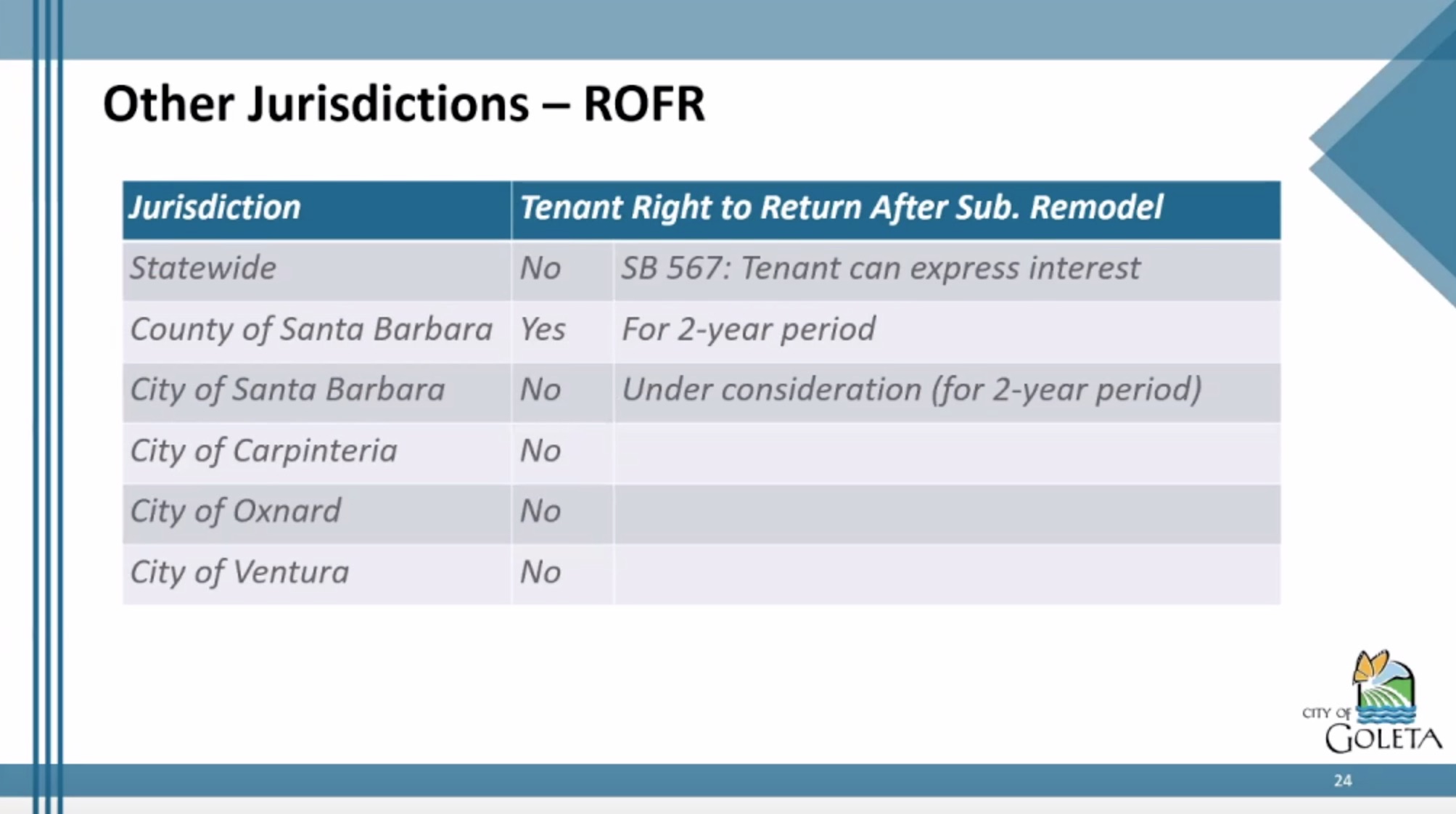
Premier Events
Sun, Apr 28
6:00 PM
Santa Barbara
AHA! Presents: Sing It Out!
Thu, May 02
5:00 PM
Santa Barbara
Things with Wings at Art & Soul
Sat, May 04
10:00 AM
Lompoc
RocketTown Comic Con 2024
Sat, Apr 27
11:00 AM
Santa Barbara
Santa Barbara Plant Fest
Sat, Apr 27
3:30 PM
Santa Barbara
Santa Barbara Trapeze Co and Unity Shoppe Spring Food Drive
Sat, Apr 27
8:00 PM
Santa Barbara
Beau James Wilding Band Live
Sun, Apr 28
11:00 AM
Santa Barbara
Santa Barbara Earth Day Festival 2024
Wed, May 01
7:30 PM
Santa Barbara
American Theatre Guild Presents “Come From Away”
Thu, May 02
5:00 PM
Santa Barbara
100th Birthday Tribute for James Galanos
Thu, May 02
5:00 PM
Santa Barbara
Meet the Creator of The Caregiver Oracle Deck
Fri, May 03
4:00 PM
Santa Barbara
Santa Barbara Fair+Expo “Double Thrill Double Fun”
Fri, May 03
8:00 PM
Santa barbara
Performance by Marca MP
Sat, May 04
10:00 AM
Solvang
Touch A Truck
Sun, Apr 28 6:00 PM
Santa Barbara
AHA! Presents: Sing It Out!
Thu, May 02 5:00 PM
Santa Barbara
Things with Wings at Art & Soul
Sat, May 04 10:00 AM
Lompoc
RocketTown Comic Con 2024
Sat, Apr 27 11:00 AM
Santa Barbara
Santa Barbara Plant Fest
Sat, Apr 27 3:30 PM
Santa Barbara
Santa Barbara Trapeze Co and Unity Shoppe Spring Food Drive
Sat, Apr 27 8:00 PM
Santa Barbara
Beau James Wilding Band Live
Sun, Apr 28 11:00 AM
Santa Barbara
Santa Barbara Earth Day Festival 2024
Wed, May 01 7:30 PM
Santa Barbara
American Theatre Guild Presents “Come From Away”
Thu, May 02 5:00 PM
Santa Barbara
100th Birthday Tribute for James Galanos
Thu, May 02 5:00 PM
Santa Barbara
Meet the Creator of The Caregiver Oracle Deck
Fri, May 03 4:00 PM
Santa Barbara
Santa Barbara Fair+Expo “Double Thrill Double Fun”
Fri, May 03 8:00 PM
Santa barbara
Performance by Marca MP
Sat, May 04 10:00 AM
Solvang



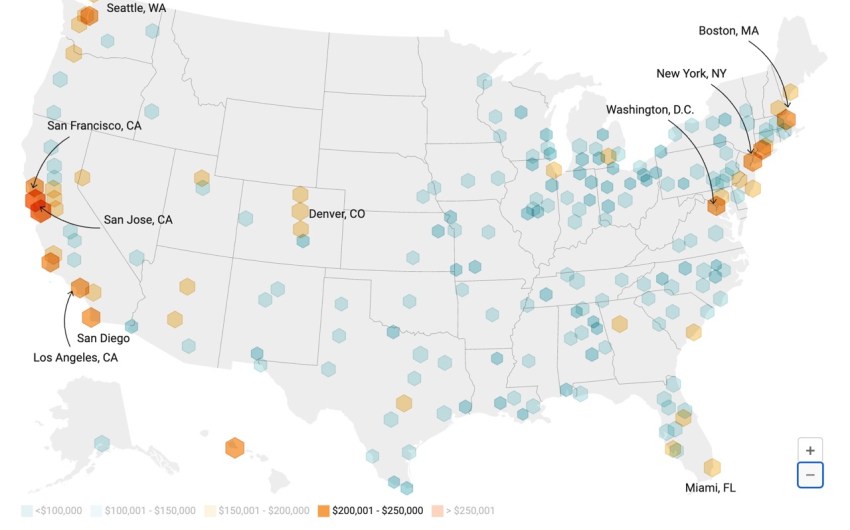




















You must be logged in to post a comment.